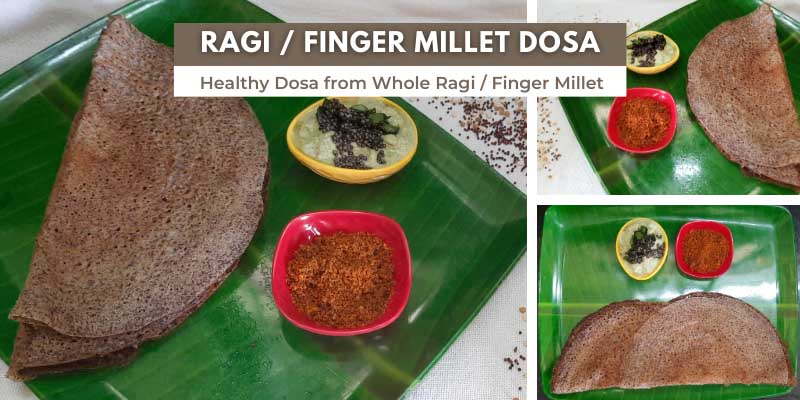
Ragi dosa is very unique and easy to prepare. Ragi / Finger Millet is healthy to our body. Yes correct! Instead of ragi flour, I used whole Ragi / Finger Millet. So it is a gluten free recipe. Ragi is finger millet and this is famous in Karnataka. In Maharashtra it’s called by Nachani and Nagali in Gujarat.
The Ragi dosa is made with whole ragi / finger millet, urad dal, fenugreek seeds and salt. Soak the ragi and dal for a few hours, grind or blend it and keep for fermentation. Next day morning you can easily prepare a healthy breakfast. Ragi and dal soak separately or together for a few hours. It must be washed a couple of times. Because ragi / finger millet have more dust and unwanted things in it.
Ragi dosa batter should be fermented. Batter should not be very thick and thin and if it is thick add some water and dilute. While adjusting with water be careful. Batter should be in a thick ribbon like consistency while spreading. Heat the iron cast tawa for dosa, spread the little oil to tawa and allow to heat. Once tawa is heated pour the batter in the middle and spread gently. Once done with spreading, allow to cook. You can apply oil or ghee on top of dosa. With the help of spatula flip the dosa and leave until for a minute.
Transfer the yummy ragi dosa to a plate and serve with chutney, sambar or different types of jam. Dosa is most suited with green chutney. Ragi dosas colour may not be attractive but it is crunchy and tastier when it is warm. After cooling it will become soft and taste wise also it will not be so good. From this batter instead of dosa you can also prepare idli, uthappa and paddu.
Usually ragi is suggested to mothers of young toddlers. Make the powder of ragi and give it to the baby like porridge. And ragi porridge is quite popular. This is the first solid food introduced to a toddler in South India. Because it supplies all nutrition and easily digestible food.
Whole Ragi / Finger Millet is very good for our body. It will help in weight loss, help reduce cholesterol and sugar level. Ragi contains high fiber, protein and minerals, calcium, iron content and is easily digestible.
Thank you guys for reading and giving valuable time to my article. Stay connected to the next recipe.
Health Benefits of Ragi / Finger Millet:
- High protein content: Ragi has a high protein content that is comparable to rice and quite distinct. Eleusinin has a high biological value, which means it is easily absorbed by the body. It also contains high levels of tryptophan, cystine, methionine, and total aromatic amino acids, all of which are essential for human health. Finger millet is a critical component in the prevention of malnutrition.
- Rich source of minerals: Ragi is a great source of minerals. It contains 5-30 times the calcium content of other cereals. It also contains a lot of phosphorus, potassium, and iron. Calcium is, of course, essential for maintaining bone density and health. As a result, finger millet would be a healthier option for people who are at risk of osteoporosis or have low haemoglobin levels.
- Controls diabetes: As the prevalence of diabetes rises, people consume foods rich in complex carbohydrates, dietary fibre, and beneficial phytochemicals. When compared to grains such as barley, rice, maize, and wheat, the seed coat of finger millet is higher in polyphenols. Diabetics have shown promise in terms of accelerating wound healing.
- Anti-microbial properties: Finger millet has been found to act against a number of bacteria including Bacillus cereus, which causes food poisoning, Salmonella sp., which causes a typhoid-like fever, and Staphylococcus aureus, one of the primary causes of skin and soft tissue infections such as abscesses, furuncles, and cellulitis.
- Anti-cancer potential: Finger millet is also rich in antioxidants, which prevent excessive oxidation, which could otherwise cause cancer and ageing because of cell damage. In general, it has been shown that people on millet-based diets have lower incidences of esophageal cancer than those on wheat or maize-diets.
- Ragi keeps you young: Finger millet and kodo millet have shown promise in inhibiting collagen cross-linking. Cross-linking of collagen is the formation of cross-links between or within collagen molecules in tendons, skin, and even blood vessels. Cross-linking reduces the ability of collagen to give tissues elasticity, resulting in the stiffness commonly associated with ageing.
- Reduces “bad” cholestrol, prevents cardiovascular disease: Finger millet lowers serum triglyceride levels and inhibits lipid oxidation and LDL cholesterol oxidation. LDL (Low Density Lipoprotein) cholesterol is referred to as “bad” cholesterol, and it becomes especially problematic when oxidised. Oxidized LDL causes artery inflammation, increasing the risk of heart attack or stroke.
TrendyAngel Kitchen | Vegetarian Food | Healthy, Traditional, Modern, Regional & More.
Like TrendyAngel Kitchen on Facebook: https://www.facebook.com/trendyangelkitchen
Follow TrendyAngel Kitchen Instagram: https://www.instagram.com/trendyangelkitchen
Like, Share & Subscribe on YouTube: https://www.youtube.com/c/TrendyAngelKitchen
All Recipes in TrendyAngel Kitchen Website: https://trendyangel.in/
